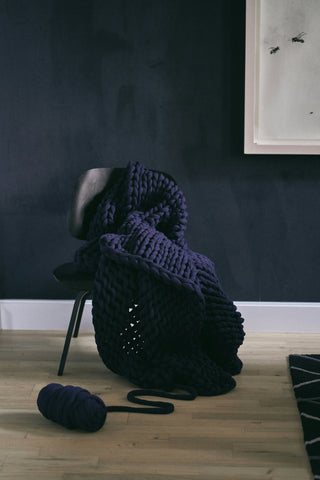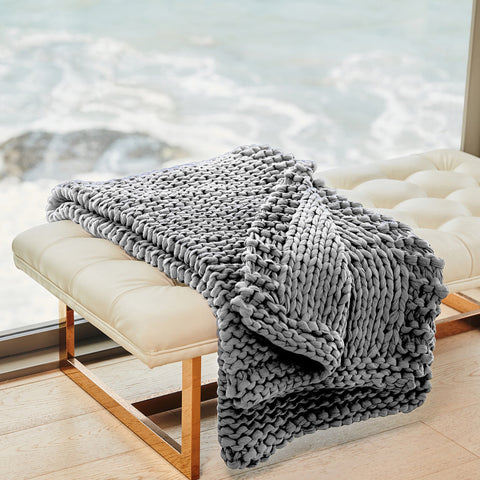
Weighted Blanket vs Comforter
When it comes to getting a good night's sleep, the debate between a weighted blanket vs comforter is more relevant than ever. Both have their unique benefits, but which one is right for you?
In this guide, we'll dive deep into the world of sleep comfort, exploring the distinct characteristics of weighted blankets and comforters. We'll help you understand what a weighted blanket is, what sets a comforter apart, and provide you with the insights you need to make the best choice for your sleep preferences.
Here's what you should know.
What this article covers:
What Is a Weighted Blanket?
A weighted blanket is a blanket filled with materials. Whats in a weighted blanket, you ask? Some manufacturers us glass beads or plastic pellets to add weight. Some are even woven in such a way to create weight without fillers. THes
This weight provides a firm pressure across the body, mimicking a therapeutic technique known as deep pressure stimulation. Based on our observations, this has been shown to promote relaxation and improve sleep quality by helping to reduce cortisol levels.
The weighted blanket benefits don't stop there; they may also increase serotonin and melatonin levels in the body.
For those interested in experiencing the comfort of a weighted blanket, our 12lb weighted blanket at California Design Den is an excellent choice. Hand-knitted by artisans, this cotton blanket offers superior breathability, making it perfect no matter the weather.
The natural hypoallergenic properties of the cotton, combined with the blanket's filler-free design, ensure a sleep experience that's not only cozy but also healthy.
Easy to maintain and machine washable, this blanket is practical for everyday use. For readers asking, “which weighted blanket is best for me?” we offer three sizes and weights (10 lb, 12 lb, and 15 lb) to cater to different preferences.
What Is a Comforter?
A comforter is a thick, fluffy bedding accessory designed to sit atop your bed, providing warmth. It's typically filled with synthetic fiber, down, or a blend of materials, and is encased in a soft outer shell, often made of cotton or polyester.
Our research indicates that the primary purpose of a comforter is to keep you warm during the night, but it also plays a significant role in the aesthetic appeal of your bedroom, adding color, texture, and style.
The quality of a comforter is often determined by its fill power, which measures the loft or fluffiness of the down used, indicating its insulating effectiveness. Higher fill power means better insulation and less weight.
Our European comforter boasts a fill power of 675. Crafted with pure cotton fabric, this comforter promises an irresistibly soft touch and a luxurious sleeping experience. Its natural down fill ensures an even thickness throughout, eliminating the discomfort of cold spots and lumps for a smooth, consistent warmth.
Weighted Blanket vs. Comforter: Which to Choose?
Choosing between a weighted blanket and a comforter boils down to personal needs. Both offer specific benefits that cater to different aspects of sleep comfort and wellness. Here are some points to consider.
Choosing A Weighted Blanket
Opt for a weighted blanket if you wish to promote relaxation and enhance your sleep. It can increase serotonin and melatonin levels while decreasing cortisol levels. This makes it particularly beneficial for individuals with anxiety, insomnia, or ADHD.

When selecting a weighted blanket, consider your body weight. Our findings show that a general guideline is to choose one that's approximately 10% of your body weight. This way, the blanket provides enough pressure for comfort without being overwhelming.
Additionally, what are weighted blankets made of plays a crucial role in comfort and hygiene. Look for breathable fabrics like cotton to prevent overheating.
Choosing A Comforter
Select a comforter if you're hunting for warmth and aesthetic appeal. Comforters are versatile, available in a wide range of materials, weights, and designs to suit different climates and decor styles.
For those in colder environments, one of our down or down-alternative comforters will provide superior warmth without excessive weight.
The fabric of the comforter's shell is another consideration. Natural fibers like cotton are breathable and soft, making them comfortable for a wide range of temperatures.
For those with allergies, hypoallergenic materials or down-alternative fillings can provide the plushness of a down comforter without the allergens.
Conclusion
The quest for the perfect night's sleep leads many to ponder the choice between a weighted blanket and a comforter. Each offers a unique path to comfort, but the right selection can transform your sleep experience.
Weighted blankets, with their deep pressure stimulation, cater to those seeking a sense of security and improved sleep quality, particularly beneficial for individuals dealing with anxiety or sleep disorders.
Comforters, on the other hand, offer a different kind of comfort with their fluffy warmth and aesthetic versatility, ideal for those who value both coziness and style in their sleep sanctuary.
Whether you're drawn to the therapeutic embrace of a weighted blanket or the luxurious softness of a comforter, California Design Den offers a curated selection to meet your needs. Explore our collection and take the first step towards upgrading your rest.
If you want to learn more, why not check out these articles below:
- How to Use a Weighted Blanket
- How to Wash a Weighted Blanket
- Best Cal King Sheets
- Best Split King Adjustable Bed Sheets
- Best Deep Fitted King Sheets
- Best Deep Pocket Cal King Sheets
- Best Sheets
- Most Luxurious Sheets
- Are Weighted Blankets Good for Arthritis
- Are Weighted Blankets Hot
- Are Weighted Blankets Washable?
- Are Weighted Blankets Worth It
- Best Knit Weighted Blanket
- Can I Put My Weighted Blanket in the Dryer
- Can You Dry a Weighted Blanket?



